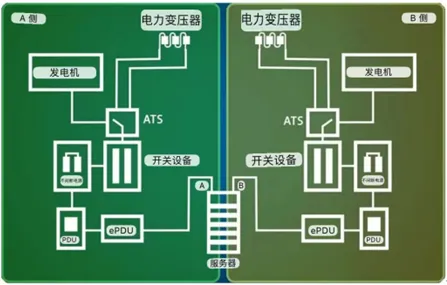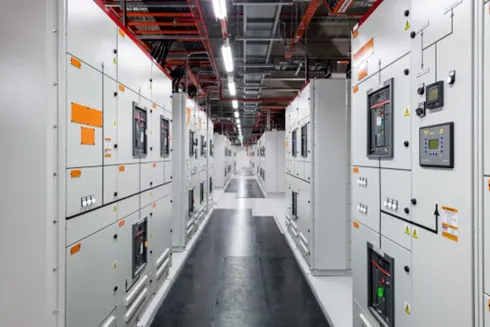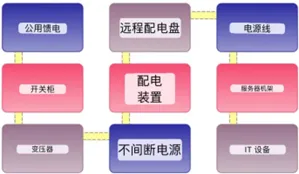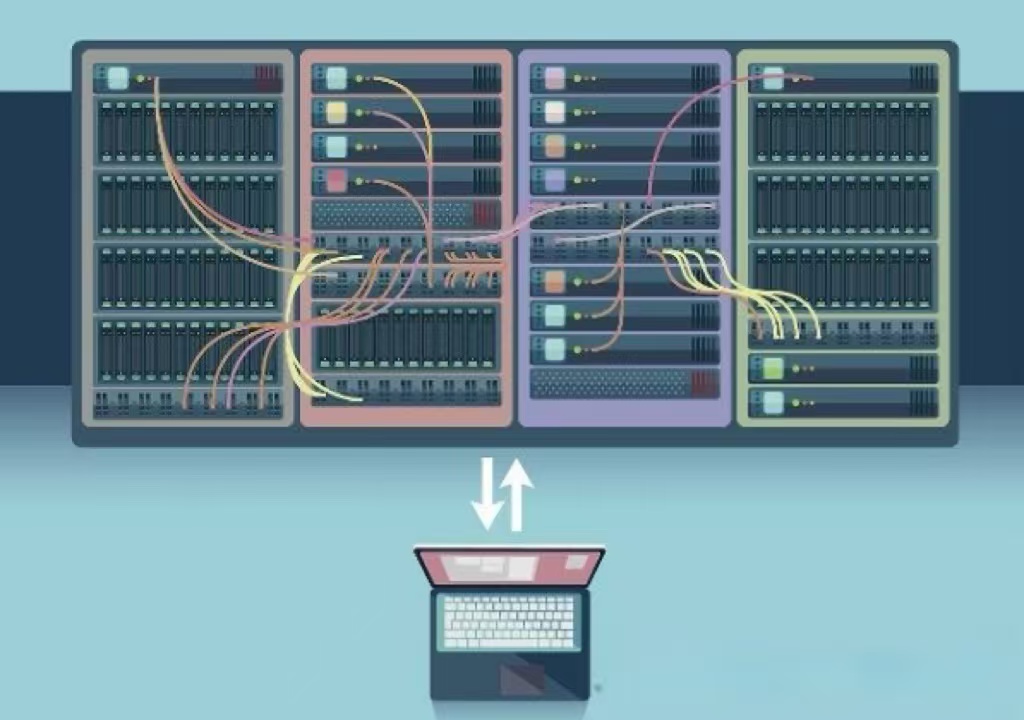
数据中心电力:能源的综合概述
Data Center Power: A Comprehensive Overview of Energy
本文以浅显易懂的方式概述了数据中心对电力的需求、电力的来源、如何将电力分配至数据中心并传输至各末端设备、哪些环节需要用电、用电量多少、如何合理用电以及冗余系统的作用和方式。相信读者阅读后,能够对数据中心的电力分配建立整体的认知。
This paper outlines in an easy-to-understand way the demand for power in a data center, where the power comes from, how the power is distributed to the data center and transmitted to each end device, which parts of the process require power, how much power is used, how we use power wisely, and what and how redundant systems work. It is believed that readers will be able to establish an overall knowledge of power distribution in data centers after reading this.
电力是数据中心的支柱,它务必要确保其IT基础设施在发生中断时仍能正常运行。电力通常是运行数据中心最大的开支。如果电力过度使用或分配不当,不仅会增加成本,还会造成浪费;而电力利用不足则可能在工作负载激增时导致危险的电压浪涌。
Power is the backbone of a data center, ensuring its IT infrastructure remains operational, even amidst interruptions. It often constitutes the largest expenditure in running a data center. Overutilization or improper distribution of power in a data center is not only costly but also wasteful, while underutilization can lead to damaging power surges during workload spikes.
电力,尤其是以电能的形式,对数据中心至关重要,因为它用于运行服务器、冷却系统、存储系统、网络设备、备份系统、安全系统和照明设备,这些系统共同支持数据的存储、管理和分发。
Power, specifically in the form of electricity, is fundamental to data centers because it is required to run the servers, cooling systems, storage systems, networking equipment, backup systems, security systems, and lighting that allow for data storage, management, and distribution.
电力消耗是数据中心运营中的关键环节,但其中的复杂性远不止瓦特和伏特的计量。从探究数据中心中哪些设备消耗最多电力,到解析电力分配层级的复杂性,再到了解冗余系统的作用,Dgtl Infra为您揭示这些庞大设施中的电力奥秘。深入探索数据中心充满电力的世界。
Power consumption is a crucial aspect of data center operations, but there’s more to the story than watts and volts. From exploring what consumes the most power within a data center to dissecting the complexities of power distribution hierarchies and understanding the role of redundant systems, Dgtl Infra unravels the intricacies of power in these massive facilities. Delve deeper into the electrifying world of data centers.
Why Do Data Centers Need Power?
数据中心主要依靠电力运行。了解各种配电方式、电压等级、单相或三相系统的复杂性至关重要。
Data centers predominantly function on electrical power. Understanding the intricacies of diverse power distribution methods, voltage levels, and single-phase or three-phase systems, is crucial.

-
服务器: 服务器的核心部件,如中央处理器 (CPU)、内存 (RAM)、硬盘驱动器和风扇,都需要电能才能运行
-
Servers: Servers, with their core components such as the central processing unit (CPU), memory (RAM), hard drives, and fans, all need electrical power to operate
-
冷却系统: 数据中心容纳服务器、存储系统、网络设备、电源设备和照明设备。这些设备共同产生大量热量。为避免硬件故障,必须对这些热量进行管理,这就需要电能来运行冷却系统,使这些组件保持在最佳温度下运行。
-
Cooling Systems: Data centers house servers, storage systems, networking equipment, power equipment, and lighting. These elements collectively generate a significant amount of heat. To avoid hardware failures, this heat must be managed, which requires power to run cooling systems that keep these components at an optimal temperature
-
存储系统: 硬盘和固态硬盘在旋转磁盘和读/写数据时耗电,在处理大量数据的数据中心尤其如此
-
Storage Systems: Hard drives and solid-state drives consume power to spin disks and read/write data, particularly in data centers that handle vast amounts of data
-
网络设备: 数据中心需要路由器、交换机和防火墙等大量网络设备来保持连接。这些设备需要电能才能运行
-
Networking Equipment: A multitude of networking devices like routers, switches, and firewalls are required in data centers to maintain connectivity. These devices need power to function
-
备用系统:为确保断电时服务的连续性,数据中心使用备用电源系统。这些系统包括不间断电源 (UPS) 系统和柴油发电机,二者都需要电能
-
Backup Systems: To ensure continuity of service in the event of a power failure, data centers utilize backup power systems. These include uninterruptible power supply (UPS) systems and diesel generators, both of which require power
-
安全系统:数据中心使用监控摄像头、门禁系统和警报器等安全系统。这些系统的运行需要电能
-
Security Systems: Data centers use security systems such as surveillance cameras, access control systems, and alarms. These systems need power to operate
-
照明:数据中心需要照明电源,以确保在设施内工作的技术人员和工作人员能够在清晰可见的情况下有效地管理其组件
-
Lighting: Data centers need power for lighting to ensure that technicians and staff members working in the facility can effectively manage its components with clear visibility
What Uses the Most Power in a Data Center?
服务器在数据中心中耗电量最大。在标准运行情况下,一台典型服务器的耗电量可能在 100 瓦到 600 瓦之间。高端服务器,特别是那些运行密集型高性能计算(HPC)任务的服务器,耗电量可达数千瓦。因此,服务器的耗电量会因执行的具体任务不同而有很大差异。
Servers use the most power in a data center. A typical server might consume anywhere from 100 to 600 watts of power under standard operation. High-end servers, particularly those running intensive high-performance computing (HPC) tasks, could draw a few thousand watts of power. Therefore, the power usage of servers can vary significantly depending on the specific tasks they are executing.

在一个典型的数据中心中,服务器本身的耗电量就占总耗电量的 50%至 70%。这是因为服务器是数量最多、最活跃的组件,全天候运行以满足用户和应用程序的需求。
In a typical data center, servers alone can account for 50% to 70% of the total power consumption. This is because they are the most numerous and active components, running 24/7 to meet the demands of users and applications.
How Much Power Does a Data Center Require?
数据中心的电力需求会因设施的规模和设计以及设备的效率而有很大不同。小型数据中心的面积在 5,000 到 20,000 平方英尺之间,服务器数量在 500 到 2,000 台之间,可能只需要 1 到 5 兆瓦(MW)的电力。
The power requirements for a data center can vary significantly depending on the scale and design of the facility, as well as the efficiency of its equipment. Small data centers, which span from 5,000 to 20,000 square feet and host between 500 and 2,000 servers, may only require 1 to 5 megawatts (MW) of power.
另一方面,大型 “超大规模 ”数据中心的面积从 10 万平方英尺到数百万平方英尺不等,可容纳数万台服务器,其电力需求从 20 兆瓦到 100 多兆瓦不等。
On the other hand, large ‘hyperscale’ data centers, ranging from 100,000 square feet to several millions of square feet and accommodating tens of thousands of servers, can demand anywhere from 20 to over 100 megawatts (MW) of power.
详细比较见下表:
For a detailed comparison, see the table below:

How Much Power Does a Server Rack Require?
一台典型服务器的耗电量在 100 到 600 瓦之间。因此,一个装满 42 台 1U 服务器的服务器机架的耗电量在 4 千瓦(kW)到 25 千瓦(不包括冷却和其他设备)之间。此外,数据中心通常还需要为服务器机架的冷却提供电力,这一过程所需的电力可能与 IT 设备本身一样多。
A typical server can consume anywhere between 100 to 600 watts of power. Therefore, a fully populated server rack, housing 42 1U servers, can consume anywhere between 4 kilowatts (kW) and 25 kW of power, not considering cooling and other devices. Additionally, data centers often need to provide power for cooling the server rack, a process that can require as much power as the IT equipment itself.

传统数据中心的功率密度平均为每个机架 4 千瓦至 6 千瓦。然而,亚马逊(AWS)等云服务提供商(CSP)和 Meta Platforms(Facebook)等大型互联网公司的运行功率密度水平为每个机架 10 千瓦至 14 千瓦。此外,用于更新、高密度人工智能(AI)工作负载的电源正在推动每个机架的功率密度超过 20 千瓦。
On average, the power density in a traditional data center ranges from 4 kW to 6 kW per rack. However, Cloud Service Providers (CSPs), such as Amazon Web Services (AWS), and large internet companies like Meta Platforms (Facebook), operate at power densification levels ranging from 10 kW to 14 kW per rack. Additionally, power for newer, high-density artificial intelligence (AI) workloads is pushing densification to exceed 20 kW per rack.
What Are Data Centers Powered By?
数据中心主要依靠电力运行。了解各种配电方式、电压等级、单相或三相系统的复杂性至关重要。
Data centers predominantly function on electrical power. Understanding the intricacies of diverse power distribution methods, voltage levels, and single-phase or three-phase systems, is crucial.

What Uses the Most Power in a Data Center?
大多数数据中心使用交流电为服务器、冷却系统和网络设备供电,尽管可能会在特殊用途下将交流电转换为直流电并为某些特别组件供电。这主要是因为大多数商业电网都供应交流电,而交流电更容易长距离配送。
Most data centers use AC (Alternating Current) power to energize their servers, cooling systems, and networking equipment, even though some components may convert this to DC (Direct Current) for specific uses. This is primarily because most commercial power grids supply AC power, which is easier to distribute over long distances.
数据中心中的交流电 (AC)
Alternating Current (AC) in Data Centers
· 输送和效率:交流电之所以被广泛使用,是因为它可以很容易地转换为较高或较低的电压,这使得它在长距离配电(如从发电厂到数据中心)时更加高效。在数据中心内,电压被降到服务器和其他 IT 设备可以使用的电压等级
· Distribution and Efficiency: AC is typically used because it can easily be transformed to higher or lower voltages, which makes it more efficient for distribution over long distances, such as from the power plant to the data center. Within the data center, the voltage is stepped down to levels that the servers and other IT equipment can use
· 服务器和 IT 设备: 数据中心中的大多数服务器、网络设备和存储设备都使用交流电,这是因为交流电与电网兼容,而且交流电的电压可以通过变压器轻松升压或降压。一些较新的设备可能会使用直流电,这是因为直流电具有电源效率高的特点,可以减少转换过程中的能源损耗。
· Servers and IT Equipment: Most servers, networking equipment, and storage devices in a data center use AC due to its compatibility with the power grid and because the voltage of AC can be easily stepped up or down using a transformer. While some newer equipment may use DC because of its power efficiency, given that this type of current reduces energy losses due to conversions
· 冷却系统:交流电用于为数据中心的冷却系统供电,如 HVAC(供暖、通风和空调)系统,该系统可为服务器和其他硬件保持最佳温度
· Cooling Systems: AC is used to power a data center’s cooling systems, like HVAC (Heating, Ventilation, and Air Conditioning) systems, which maintain an optimal temperature for the servers and other hardware
· 照明和安全系统: 交流电为数据中心的其余基础设施供电,包括照明和安全系统
· Lighting and Security Systems: AC powers the remaining infrastructure in a data center, including the lighting and security systems
数据中心的直流电 (DC)
Direct Current (DC) in Data Centers
直流电 (DC) 在数据中心的运行中扮演着次要角色,其重要性体现在以下几个方面:
Direct Current (DC) plays a secondary role in the operations of a data center, with its importance in the following areas:
-
备用系统:直流电源最常用于不间断电源 (UPS) 系统,为数据中心提供备用电源。在这些系统中使用直流电源是因为铅酸电池和锂离子电池可存储和提供直流电源
-
Backup Systems: DC power is most commonly used in Uninterruptable Power Supply (UPS) systems, which provide backup power to the data center. DC power is used in these systems because lead-acid and lithium-ion batteries store and deliver DC power
-
电源转换:服务器和其他 IT 设备的电源装置(PSU)使用直流电。因此,当交流电到达服务器时,会转换成直流电供服务器的电子元件使用。这些组件包括微处理器和内存。这一转换过程在每台服务器的 PSU 中进行
-
Power Conversion: Power Supply Units (PSUs) in servers and other IT equipment operate on DC power. Therefore, when AC power reaches the server, it is converted into DC for the server’s electronic components to use. These components include the microprocessor and memory. This conversion process takes place within the PSUs of each server
总体而言,直流配电可显著节约能源。不过,直流配电的前期成本较高,而且改造现有数据中心也比较复杂。对于新建(新建)项目,直流配电架构可能会带来长期运营成本效益,而且由于其卓越的电源效率,更具可持续性。
Overall, DC power distribution can lead to significant energy savings. However, it carries higher upfront costs and complexities associated with retrofitting existing data centers. For newly constructed (greenfield) projects, a DC power distribution architecture could potentially provide long-term operational cost benefits and be more sustainable, given its superior power efficiency.
数据中心电源电压是多少?
What Voltage is Data Center Power?
数据中心电源的电压因地区、国家标准和使用的设备类型而异。
The voltage for data center power varies depending on the region, country’s standard, and the type of equipment being used.

-
美国:在美国,小型数据中心设备和服务器的常用电压为 120V 和 208V。较大型设备(如 UPS 系统)使用 277V 或 480V,这些电压来自三相电源
-
United States: In the U.S., common voltages for smaller data center equipment and servers are 120V and 208V. Larger equipment, such as a UPS system, uses 277V or 480V, which comes from three-phase power supplies
-
欧洲:在欧洲,标准电压通常较高,服务器和小型数据中心设备通常使用 230 伏电压。大型设备使用 400 伏电压,来自三相电源
-
Europe: In Europe, the standard voltage is generally higher, often 230V for servers and smaller data center equipment. Larger equipment uses 400V, which comes from three-phase power supplies
-
亚太地区:亚太地区各国的电力标准不尽相同--大多数国家(如中国、印度、澳大利亚、新西兰和韩国)的单相电力标准为 220V 至 230V,三相电力标准为 380V 至 400V,而日本是一个例外,其标准为不常见的 100V。
-
Asia-Pacific: Power standards vary by country in Asia-Pacific – most, like China, India, Australia, New Zealand, and South Korea, use 220V to 230V for single-phase power and 380V to 400V for three-phase power, while Japan is an outlier with its uncommon 100V standard
单相与三相电源对比
Single-Phase vs Three-Phase Power
为了满足数据中心日益增长的电力需求,目前正在采用能够提供多回路、更高电压和更大电流的系统。因此,数据中心配电系统通常分为单相和三相电力系统。
To address the rising power demands in data centers, systems capable of delivering multiple circuits, higher voltages, and increased currents are being implemented. Consequently, data center power distribution is typically classified into single-phase and three-phase power systems.

单相电源
Single-Phase Power
单相电是交流电传输的一种简单形式,适用于较低的功率要求。在该系统中,电力通过一根导线(相线)传输,另一根导线(中性线)作为电流的返回路径。在主机托管数据中心,单相电源通常用于为单个小型设备供电,包括标准服务器机架、路由器和交换机。
Single-phase power is a simple form of Alternating Current (AC) power transmission and is suitable for lower power requirements. In this system, power is transmitted via a single wire (phase), and another wire (neutral) serves as a return path for the current. In colocation data centers, single-phase power is often used to energize individual pieces of smaller equipment, including standard server racks, routers, and switches.
三相电源
Three-Phase Power
三相电源广泛应用于数据中心。它采用三条不同的交流电电路,每条电路通过各自的导线输送,外加第四条中性线作为回流路径。这有效地将功率容量提高了三倍,同时还能控制电缆的体积。
Three-phase power is widely used in data centers. It employs three distinct circuits of AC power, each delivered over its own wire, plus a fourth, neutral wire as a return path. This effectively triples the power capacity while keeping the cable bulk under control.
三相电源系统可持续、平稳地提供电力,消除了电力在周期中降为零的情况。因此,三相电源系统的效率更高,能以更小的电压降提供更多的电力,而且更适合大容量、高运行时间的环境。这些特点使三相系统成为数据中心的理想选择。
Three-phase power systems deliver power constantly and smoothly, eliminating points in the cycle where power falls to zero. As a result, they are more efficient, provide more power with less voltage drop, and are better suited for high-capacity, high-uptime environments. These characteristics make three-phase systems ideal for data centers.
在相同电流数的情况下,三相电路的功率密度也比单相电路大,从而减少了电缆尺寸和成本。因此,三相电路更适合为高密度服务器机架供电,而高密度服务器机架是运行人工智能(AI)和机器学习(ML)计算的最佳选择。
A three-phase circuit also offers greater power density than a single-phase one at the same amperage, thus reducing wiring size and costs. Therefore, it is favored for powering high-density server racks, which are optimal for running artificial intelligence (AI) and machine learning (ML) computations.
为了保持持续运行,数据中心需要可靠、不间断的电力供应,这些电力主要来自当地电网,即公用事业用电。
To maintain continuous operation, data centers need a dependable, uninterrupted flow of electricity, primarily sourced from the local electrical grid, known as utility power.
How is Power Supplied to Data Centers?

从发电厂到数据中心的电力传输路径
Path of Electricity from Power Plants to Data Centers
从发电厂到数据中心的电力传输过程始于各种来源的发电。全球大部分数据中心的电力仍然来自传统电网,主要包括天然气、煤炭、石油等化石燃料,在某些地区还包括核能。
The journey of electricity from a power plant to a data center begins with the generation of electricity through various sources. The majority of data center electricity worldwide still comes from conventional grid electricity, which primarily consists of fossil fuels such as natural gas, coal, oil, and in some regions, nuclear power.
风能、太阳能和水力发电等可再生能源目前在数据中心的能源供应中所占比例较小。不过,随着数据中心越来越多地采用可持续能源,它们所占的比例也在不断增加。
Renewable energy sources, including wind, solar, and hydroelectric power, currently contribute a smaller portion to the energy supply of data centers. However, their share is growing as data centers increasingly embrace sustainability.
产生的电力最初电压较低,然后通过升压变压器转换为高压,以便进行高效的远距离输电。这种高压电通常在 155 千伏至 765 千伏之间,通过电网的输电线路输送到变电站。在这些变电站,降压变压器用于在电力分配之前降低电压。
The electricity that is generated, initially at a low voltage, is then transformed to a high voltage via a step-up transformer for efficient long-distance transmission. This high-voltage electricity, often between 155 kV to 765 kV, is transported through the transmission lines of the electrical grid to substations. At these locations, step-down transformers are used to reduce the voltage before the electricity is distributed.

电力通过配电线路传输到数据中心。在变压器的帮助下,电压可在进入设施前进一步降低。电力通常以中等电压水平进入数据中心,常见标准约为 13.2 千伏、13.8 千伏或 27.6 千伏。
Electricity is transmitted through distribution lines to data centers. Here, with the assistance of transformers, the voltage may be further reduced before it enters the facility. The electricity typically enters a data center at a medium voltage level, with common standards being approximately 13.2 kV, 13.8 kV, or 27.6 kV.
How is Power Distributed in a Data Center?
数据中心的电力分配是其设计和运行的一个重要方面。
The distribution of power in a data center is a critical aspect of its design and operation.

可靠的配电可确保构成数据中心基础设施的服务器、存储系统和网络设备持续运行。
Reliable power distribution ensures the continuous operation of servers, storage systems, and networking devices that comprise the data center’s infrastructure.
数据中心配电系统层次结构
Data Center Power Distribution Hierarchy
下面简要解释了数据中心通常是如何分配电力的:
Here’s a simplified explanation of how power is typically distributed in a data center:

-
公用馈电:数据中心的电力最初来自本地电网,也称为公用馈电。为防止出现单点故障,数据中心通常有多个来自不同电网的馈电,以实现冗余
-
Utility Feed: Power to a data center initially comes from the local power grid, also known as the utility feed. To prevent a single point of failure, data centers typically have multiple feeds from different grids for redundancy
-
开关设备:这是数据中心内公用电源的初始接触点。它将输入电源分成更小、更易于管理的电路
-
Switchgear: This is the initial point of contact for utility power within the data center. It divides the incoming power into smaller, more manageable circuits
-
变压器:在主开关柜之后,电力可能会流向变压器,变压器会将电压调整到适合数据中心基础设施的水平。变压器可根据需要升压或降压
-
Transformer: After the main switchgear, power may flow to transformers, which adjust the voltage to levels suitable for the data center infrastructure. Transformers can step up or step down voltage as required
-
不间断电源 (UPS):电源从主开关柜流向不间断电源系统。这些系统可储存能量,并在停电期间为数据中心提供应急电源(通常持续几分钟),直至发电机启动。它们还能消除电能质量问题,如可能损坏设备的骤降或浪涌。
-
Uninterruptible Power Supply (UPS): From the main switchgear, power flows to the UPS systems. These systems store energy and provide emergency power – usually lasting for a few minutes – to the data center during an outage until generators start. They also smooth out power quality issues, such as sags or surges, which could damage equipment
-
配电装置 (PDU):UPS 系统向 PDU 供电。PDU 将电源转换为适合数据中心设备的电压,然后将其分配到各个服务器机架、交换机和其他设备。为确保冗余,数据中心通常使用多个 PDU
-
Power Distribution Units (PDUs): Power is sent from the UPS systems to PDUs. PDUs convert this power into a voltage suitable for the data center’s equipment, then distribute it to individual server racks, switches, and other equipment. To ensure redundancy, a data center typically operates with multiple PDUs
-
列头柜 (RPP): 然后将电源分配到 RPP,RPP 是较小的保护机箱,内含保险丝、断路器面板和接地故障保护装置。这些设备可作为局部配电点,将从 PDU 接收的电力分成独立的电路,便于将电力分配到各个服务器机架、交换机和其他设备上。
-
Remote Power Panels (RPPs): Power is then distributed to RPPs, which are smaller protective enclosures containing fuses, circuit breaker panels, and ground fault protection devices. These function as localized distribution points, dividing the power received from the PDUs into separate circuits, which facilitate the distribution of power to individual server racks, switches, and other equipment
-
电源线:这是一种由柔性电缆组成的导管系统,用于将电力从 PDU 或 RPP 分配到数据中心内的服务器机架和其他 IT 设备。根据数据中心的设计,电源线可以架设在高架地板之下或天花板之下
-
Power Whips: These are conduit systems composed of flexible cables used to distribute power from a PDU or RPP to server racks and other IT equipment within a data center. Depending on the data center’s design, power whips can be routed overhead or beneath a raised floor
-
服务器机架: 每个服务器机架都有自己的电源插座,也称为机架 PDU。从这里为 IT 设备供电,包括机架内的单个服务器、存储系统和网络设备。
-
Server Racks: Each server rack has its own power strip, also known as a rack PDU. From here, power is provided to the IT equipment, including the individual servers, storage systems, and networking devices within the rack
这种配电流程旨在为数据中心设备提供持续、高质量的电力供应,防止潜在的断电或电能质量问题。
This power distribution process is designed to provide a continuous, high-quality power supply to the data center equipment, protecting against potential outages or power quality issues.
公用电源容量与 IT 电源容量
Utility Power Capacity vs IT Power Capacity
数据中心运营商在描述其设施的能源资源时,通常会引用两个关键指标:公用电源容量和 IT 电源容量。
Data center operators often cite two key metrics when describing their facility’s energy resources: utility power capacity and IT power capacity.

-
公用电源容量:这是数据中心可从公用电网获取的最大电量。它代表了数据中心在任何时间都能使用的电力上限,涵盖了设施的所有能源需求,包括 IT 设备、冷却、照明和其他支持系统。
-
Utility Power Capacity: This is the maximum amount of power that the data center can draw from the utility grid. It represents the upper limit of power that a data center can use at any one time, and it encompasses all energy needs of the facility, including IT equipment, cooling, lighting, and other support systems
-
IT 电源容量:这是专用于运行 IT 设备本身(包括服务器、存储设备和网络设备)的功率。该容量不包括用于冷却、照明或任何其他非 IT 功能的电力。它是确定数据中心客户租用电力的关键指标。设施运营商通常使用其他各种术语来表示 IT 功率容量,如关键负载、IT 负载和关键电源等。
-
IT Power Capacity: This is the amount of power dedicated to running the IT equipment itself, which includes the servers, storage devices, and networking equipment. This capacity does not account for power used for cooling, lighting, or any other non-IT functions. It is a crucial metric for determining the power leased by a data center customer. IT power capacity can often be referred to by facility operators using a variety of other terms, such as critical load, IT load, and critical power
参照上述配电层次结构,公用电源容量涵盖从最初的公用电源馈电到配电单元 (PDU) 的系统。另一方面,IT 电源容量从列头柜 (RPP) 开始,一直延伸到服务器机架,包括服务器、存储系统和网络设备等 IT 设备的实际配电和耗电。因此,公用电源容量和 IT 电源容量之间的转换点位于 PDU 和 RPP 之间。
Referencing the power distribution hierarchy above, utility power capacity covers the systems from the initial utility feed down to, and including, the Power Distribution Units (PDUs). On the other hand, IT power capacity begins from the Remote Power Panels (RPPs) and extends to the server racks, which includes the actual distribution and consumption of power by the IT equipment such as servers, storage systems, and networking devices. Therefore, the transition point between utility power capacity and IT power capacity is situated between the PDUs and the RPPs.
Redundant Power Systems in Data Centers
冗余电源系统是任何数据中心的重要组成部分。即使主电源发生故障,冗余电源系统也能提供持续供电,确保不间断运行。
Redundant power systems are a crucial part of any data center. They ensure uninterrupted operation by providing a continuous power supply, even if there’s a failure in the primary power source.
下面是数据中心电源基础设施的简化框图,说明了电源冗余的双路电气布局,分别标为 A 侧和 B 侧。这种设置可确保服务器不间断运行。
Below is a simplified block diagram of a power infrastructure for a data center, illustrating a dual-path electrical layout for power redundancy, labeled A-Side and B-Side. This setup ensures uninterrupted server operation.

Components of Redundant Power Systems in Data Centers
数据中心冗余电源系统的主要组成部分包括:
The key components of a redundant power system in a data center include:
不间断电源(UPS)
Uninterruptible Power Supplies (UPS)
不间断电源 (UPS) 系统可在主电源发生故障时提供应急电源,通常可持续几分钟,直到发电机启动。与辅助或应急电源系统不同,UPS 通过提供储存在电池(铅酸电池或锂离子电池)或飞轮中的能量,为电力中断提供近乎瞬时的保护。
Uninterruptible Power Supply (UPS) systems provide emergency power when the primary power source fails, usually lasting for a few minutes until generators start. Unlike auxiliary or emergency power systems, a UPS offers near-instantaneous protection from power interruptions by supplying energy stored in batteries (either lead-acid or lithium-ion) or flywheels.
以下是对这些蓄电池组进行目视检查的示例,以确保蓄电池组充满电,随时可以启动:
Below is an example of the visual inspections conducted on these battery banks to ensure they are charged and ready for activation at any moment:

备用发电机
Backup Generators
在长期停电的情况下,备用发电机可为数据中心供电。这些发电机通常由柴油或汽油驱动,可长时间运行。
In the event of a long-term power outage, backup generators can supply power to the data center. These generators are usually diesel- or gas-powered and can operate for extended periods.

配电装置 (PDU)
Power Distribution Units (PDUs)
PDU 将电力分配给数据中心内的各个组件。为了提供冗余并确保服务器和其他设备的不间断供电,需要使用多个 PDU,以减轻单个 PDU 故障造成的影响。
PDUs distribute electrical power to the various components within the data center. To provide redundancy and ensure an uninterrupted power supply to servers and other equipment, multiple PDUs are used, mitigating the impact of a single PDU’s failure.
转换开关
Transfer Switches
自动转换开关 (ATS) 用于在断电时将电源从主电源(通常是市电)转换到 UPS 或发电机。
An Automatic Transfer Switch (ATS) is used to switch the power source from the main supply (typically the utility power) to the UPS or generator in the event of a power failure.

相比之下,静态转换开关(STS)可在主电源不可用或超出可接受的参数时,快速切换到替代电源,如市电备用电源、UPS 或备用发电机。
In contrast, a Static Transfer Switch (STS) facilitates rapid switching to an alternative power source, such as a second power feed from the utility company, a UPS, or backup generator, if the primary source becomes unavailable or falls outside of acceptable parameters.
冗余电源路径
Redundant Power Paths
为避免单点故障,数据中心通常使用冗余电源路径。这种方法为从电源(如本地电网或备用发电机)到 IT 设备的电力传输创建了单独和独立的路径。在实践中,UPS 模块为独立的配电面板供电,这些配电面板支持每个 IT 设备单元内的不同电源。一个 UPS 支持 IT 设备中的单一电源路径和特定电源,而另一个 UPS 则支持备用电源。
To avoid a single point of failure, data centers often use redundant power paths. This approach creates separate and independent paths for power to travel from the source (e.g., the local power grid or backup generators) to the IT equipment. In practice, UPS modules feed separate distribution panels that support distinct power supplies within each IT equipment unit. One UPS sustains a single power path and a specific power supply in the IT equipment, while another UPS supports the alternate power supply.
数据中心电力系统冗余方法
Power System Redundancy Methods in Data Centers
在数据中心,冗余方法对于保持系统稳定性和正常运行时间至关重要。数据中心电力系统的主要冗余方法包括
In data centers, redundancy methods are crucial for maintaining system stability and uptime. The primary redundancy methods for power systems in data centers include:
N" 方法
‘N’ Method
N "方法指的是在正常情况下为数据中心供电、冷却和备份所需的容量。它没有为设备故障预留额外容量,也就是说没有冗余。
The ‘N’ method refers to the capacity needed to power, cool, and back up the data center under normal conditions. It does not have extra capacity built in for equipment failure, meaning it has no redundancy.
N+1 或 N+X 冗余
N+1 or N+X Redundancy
N+1 或 N+X 冗余确保除了必要的组件外,还有一个或'X'个备用组件(如 UPS、HVAC 或发电机系统)。'+'号表示在主组件发生故障时,有备用组件可以接替。电源从公用设施流出,通过 UPS/PDU 连接到服务器。在 N+1 框架内,有不同的策略可提供不同程度的容错:
N+1 or N+X redundancy ensures that there is one or ‘X’ number of backup components (such as UPS, HVAC, or generator systems) in addition to the necessary components. The ‘+’ sign indicates that there are backup components available that can take over if a primary component fails. Power flows from the utility, through the UPS/PDU, and connects to the server. Within the N+1 framework, there are different strategies that provide varying levels of fault tolerance:
-
N+1 块冗余:每个组件都至少有一个备用备份,确保系统的稳健性
-
N+1 Block Redundant: Every single component has at least one spare backup, ensuring system robustness
-
N+1 分布式冗余:备份组件分散在整个系统中,需要时可立即接管
-
N+1 Distributed Redundant: Backup components are dispersed throughout the system for immediate takeover if needed
-
N+1 隔离并行总线:每个组件都有一条额外的隔离总线,故障时可立即接管
-
N+1 Isolated Parallel Bus: Each component has an extra, isolated bus ready for immediate takeover upon failure
2N 冗余
2N Redundancy
2N 冗余方法是在原有 “N ”的基础上再增加一组完全冗余的 “N”,即使原有的 “N ”全部失效,系统也能正常运行。从本质上讲,该系统拥有双倍必要的不间断电源、暖通空调和发电机系统,以提供完全的容错能力。电力从公用设施流出,经过两个独立系统的不间断电源/PDU,然后连接到服务器。
The 2N redundancy approach involves a fully redundant set of ‘N’ in addition to the original ‘N’, allowing the system to operate normally even if the entire original ‘N’ fails. Essentially, the system has double the necessary UPS, HVAC, and generator systems to provide full fault tolerance. Power flows from the utility, passes through the UPS/PDU of two separate systems, and then connects to the server.
2N+1 冗余
2N+1 Redundancy
2N+1 冗余方法结合了 2N 和 N+1 的概念。它将必要的容量(2N)增加一倍,并在 N 架构的每个元素中增加一个额外的备份组件。它具有很强的恢复能力,能够承受多个组件故障。即使主系统离线,N+1 冗余也能持续。
The 2N+1 redundancy method combines the concepts of 2N and N+1. It doubles the necessary capacity (2N), plus adds an extra backup component to each element of the N architecture. It offers high resilience and is capable of withstanding multiple component failures. Even when the primary system is offline, N+1 redundancy is sustained.
3N/2 冗余
3N/2 Redundancy
3N/2 冗余配置实际上介于 N 和 2N 冗余之间。这意味着数据中心的整个基础设施是为处理 1.5 倍于 “N ”的基本负载而设计的。这意味着,即使整个系统的一半出现故障,其余系统仍可正常运行。
The 3N/2 redundancy configuration is effectively halfway between N and 2N redundancy. It implies that the total infrastructure of the data center is designed to handle 1.5 times the base load of ‘N’. This means that even if half the total system fails, the remaining system will still operate normally.
数据中心电力系统冗余的权衡取舍
Trade-Off of Power System Redundancy in Data Centers
数据中心的电力系统冗余有成本效益高的 N 配置(不提供备用容量),也有可靠性高但成本高的 2N+1 方法(在多个组件出现故障时仍能保持冗余)。N+1、2N 和 3N/2 等配置可在成本适中的情况下兼顾弹性。
Power system redundancy in data centers ranges from the cost-efficient N configuration, which offers no backup capacity, to the highly reliable but expensive 2N+1 method, which maintains redundancy despite multiple component failures. Configurations like N+1, 2N, and 3N/2 offer a balance of resilience at a moderated cost.
Frequently Asked Questions
What is Data Center Energy Infrastructure?
数据中心能源基础设施是指供应、分配和管理数据中心设施运行所需电力的系统和设备。这包括发电系统(如公用电网、现场发电机)、配电系统(如变压器、开关设备、不间断电源)以及管理 IT 设备产生的热量的冷却系统等组件。可靠、高效的能源基础设施对于为数据中心供电、确保托管 IT 系统和服务的持续运行至关重要。
Data center energy infrastructure represents the systems and equipment that supply, distribute, and manage the power required to operate the data center facility. This includes components such as power generation sources (e.g., utility grid, on-site generators), electrical distribution systems (e.g., transformers, switchgear, uninterruptible power supplies), and cooling systems to manage the heat generated by the IT equipment. Reliable and efficient energy infrastructure is essential to power data centers and ensure continuous operation of the hosted IT systems and services.
 English (UK)
English (UK)

























